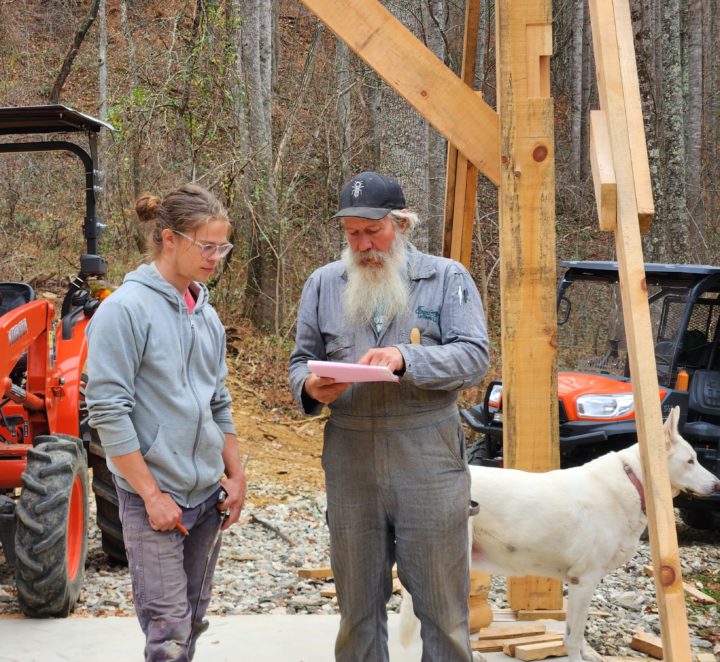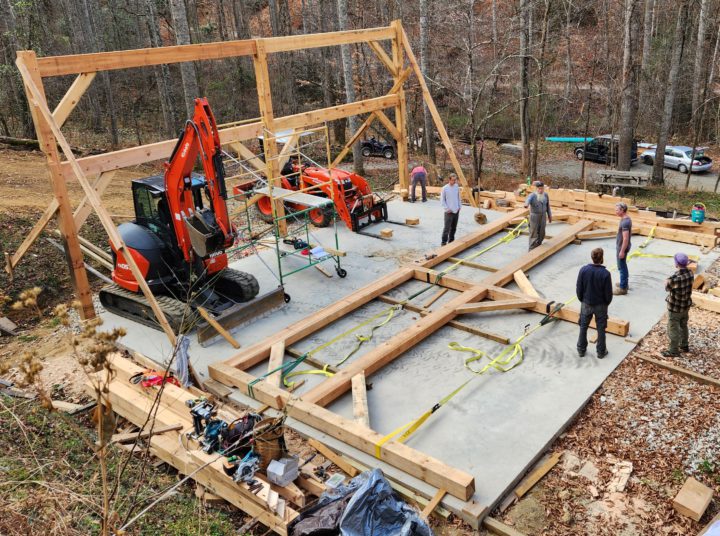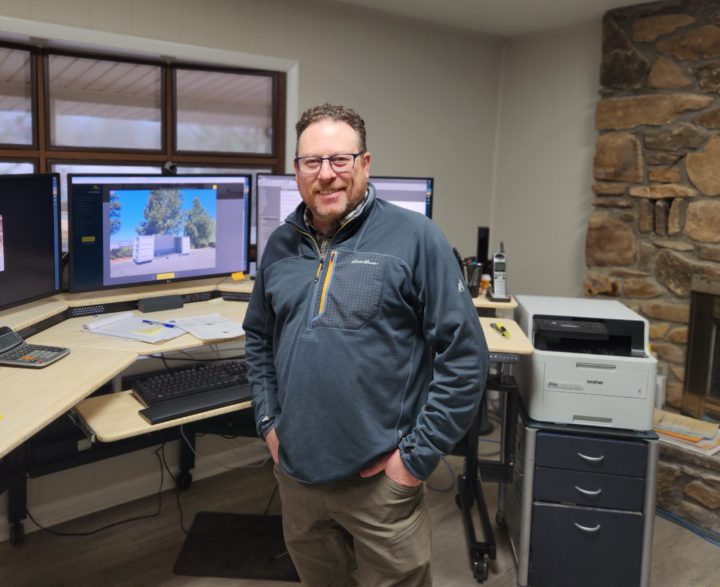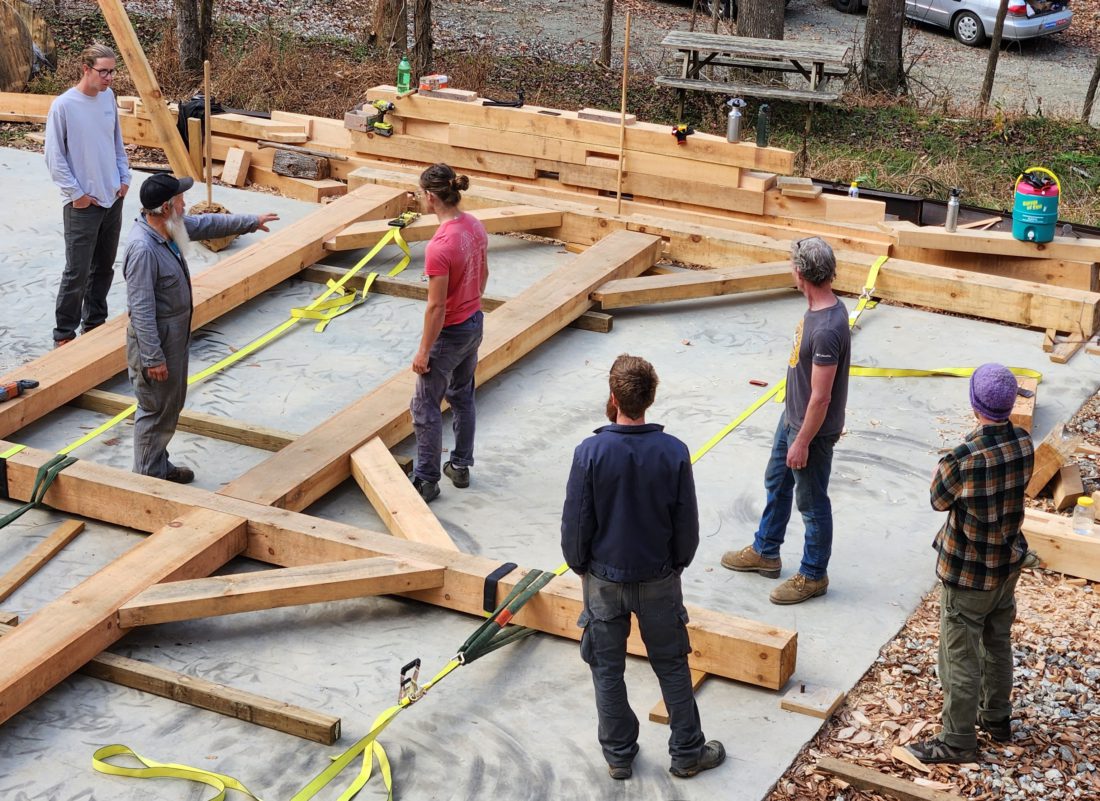It’s not every day you get invited to a barn raising, so when I did, I jumped at the opportunity.
The event took place on a 300-acre parcel southwest of Marshall owned by Chris Allen and Daniel Larkin. They have managed the restorations of numerous houses in New Orleans’ French Quarter, so when they moved to North Carolina and it was time to build a place to store their machinery, they didn’t want any old barn. They wanted a building that would be just as beautiful as it was lasting and structurally sound.
Timber framing was an obvious choice. A traditional method of building with heavy timbers connected with “mortises and tenons,” simple but strong joints often secured by wooden pegs, timber framing was the predominant building method in Europe for more than 1,000 years. It was equally popular in the U.S. until dimensional lumber — wood cut to standard widths and depths such as two-by-fours — became widely available at the end of the 19th century and stick-built houses became the norm. Equally suitable for high-end homes and do-it-yourself projects, timber framing is enjoying a renaissance in Western North Carolina.
To build their barn, Allen and Larkin hired Barron Brown, a timber framer whose work is held in such high regard that, even though he has an unlisted phone number and doesn’t advertise, there’s always a long waitlist for his services. Brown learned the basics of timber framing while building a chicken coop with his grandparents on their Lucketts, Va., farm in 1964.

“I was 6 years old when we started building these,” he says. “There wasn’t a lot of cash floating around. We would just cut down trees and make beams and posts and put them together, which was what was done before Home Depot came into being.”
After graduating with an engineering degree from Vanderbilt in 1980, he worked for the National Bureau of Standards and the Italian government before quitting to make art. Brown has sold some of his sculptures but derives most of his income from building houses. He likes building because it comes easily to him and satisfies his desire to “make things.” It also allows him to be particular about the projects he chooses. Unlike most builders, he looks for clients who are willing to invest some sweat equity. “I like to work on projects with the homeowners present,” he says. “It makes the communication loop way shorter, so there’s no misunderstandings.”
At the barn raising, Allen and Larkin worked alongside a handful of others who were there to help out and gain experience. Brown only had one paid employee on-site, his project manager Andrew Vice. A graduate of the American College of the Building Arts in Charleston, S.C., Vice has been working with Brown for nearly 15 years. Brown often defers to him. “You might ask Andrew,” he says at one point. “He might have a different opinion.”
The goal for the day was to raise the barn’s second “bent,” one of a timber-frame structure’s load-bearing walls with beams that run perpendicular to the ridge. To tap the components of the bent into place, Vice used a “commander,” a large mallet with a log for a head and a tree limb for a handle. When it broke, he fashioned another from a large chunk of locust and an old ax handle.

Brown can build a structure solely with hand tools such as a commander and an assortment of saws and chisels, but he’s not a masochist or a Luddite. While he did eat lunch using a spoon he’d carved out of a piece of wood, he also used the design software TurboCAD to design the barn and power tools to make all the mortises and tenons in the lumber. An excavator did much of the heavy lifting to raise the bent. A crane would have made the job easier, but the steep terrain didn’t allow for one. Nine of us did the rest, using two wooden braces on each side to lift the bent ever higher, several inches at a time.
A new way for an old craft
I didn’t realize just how old-school Brown’s operation is until I spoke with Tom Rouse, the owner of Timberframe Horizons. His crew uses 12-pound, dead-blow hammers instead of commanders, and some of their saws cost as much as a used car. They also cut and preassemble much of the timber they use in a brand-new shop just off U.S. 70 in Swannanoa.
It wasn’t always this way.
A dedicated outdoorsman — he lists rock climbing, mountain biking, skiing and snowboarding among his interests — Rouse discovered timber framing in the late 1990s while attending an adventure camp at the Turtle Island Preserve near Boone. His first job was working for an old-timer named Elwood in Sky Valley near Brevard, where he cut his first joints while making a set of stairs.
During a 1,600-mile bicycle tour around the British Isles, Rouse observed how elegant the old timber-frame houses he saw looked and how well they were holding up. It inspired him to start working for Blue Ridge Timber Frame in Swannanoa after he returned to Asheville. The company didn’t have a designer, so Rouse, who prides himself on “jumping in and figuring things out,” taught himself how to use AutoCAD. The next thing he knew he was the head of the company’s design department.

When Blue Ridge Timber Frame folded in 2013, Rouse started his own company. Timberframe Horizons’ first big job was a barn restoration at the Knights Hill Plantation in Camden, S.C., which required four tractor-trailer loads of reclaimed timber. For that project, he leased a shop in Old Fort, where his company was based until he moved the operation to Swannanoa. His new shop boasts giant windows, radiant-heat floors and plenty of room.
“With this amount of space, we can assemble an entire house in here,” says Andy Harvey, one of Timberframe Horizons’ two lead timber framers. “It decreases our footprint on-site.”
While Brown’s operation thrives on word-of-mouth, Timberframe Horizons has a slick website, a strong social media presence, and multiple projects in the works at any given time. When I visited its headquarters, I observed a whiteboard filled with nearly a dozen jobs in progress. Some of the more visible projects the company has worked on in the past include the North Asheville Public Library, the Weaver House, the Salt Face Mule Brewing Co. and the Grove Park Inn.
‘Trimber framing’
Timberframe Horizons is working on a project at Cataloochee Ranch in Maggie Valley. For this job, Rouse had to order locust from Wisconsin, which underscores a major difference between his company and Brown’s. Given the size of his operation, Rouse often experiences supply-chain issues with local materials, forcing him to order lumber from afar.
Content with building one or two timber-frame structures a year, Brown tries to get his lumber from a source as close as possible to the building site and usually succeeds. “If I’m in Madison County, I get wood in Madison County,” he says. “If I’m in Yancey County, I get wood in Yancey County.” For the barn near Marshall, he bought all his wood from Big Pine Log and Lumber north of Marshall.
Rouse’s crew is also more apt to use heavy machinery than Brown’s, frequently employing a CNC machine to make repetitive cuts and using cranes and forklifts to set bents in place. That’s not to say that Rouse’s company produces cookie-cutter houses. Every home it builds is custom-made, and no two projects are the same.
Similar to the way Brown depends on Vice, Rouse relies on Harvey, an experienced woodworker who trained as a shipwright in Wilmington, and his other lead timber framer, Chris Kagan, who worked with famed timber framer Tedd Benson in New Hampshire before moving to Asheville in 2006.
During a conversation in Timberframe Horizon’s shop, Harvey lamented the popularity of “faux timber framing” in the area. Some builders incorporate the look of timber framing in their projects without incorporating any of its functionality. For example, they might install an exposed beam in a stick-built house that’s aesthetically pleasing but doesn’t provide any structural support. “If people can get to us earlier in the process, we can build them an actual timber structure,” Harvey says.
Brown and Vice’s sardonic term for this practice is “trimber framing.” “People have been doing this for a long time,” says Brown. “I don’t fault them for it, but I think it’s kind of silly because I like the form-follows-function design philosophy.”
Leaving a legacy
When Brown isn’t building timber-frame houses, he spends much of his time making sculptures. His pieces have been displayed at the Burnsville Town Center, Asheville’s River Sculpture Festival, the N.C. Arboretum, and the courthouse lawn in Brevard, and on more than one occasion, he’s helped the renowned visual artist Mel Chin set up one of his works.
Brown also teaches workshops on woodcarving and blacksmithing and is a regular instructor at the Firefly Gathering. In the little downtime he has, he retreats to his homestead in Yancey County, where he lives with his wife, Karen. She wants him to retire. He could if he wanted to. “I’ve got my mortgage paid off,” he says, “and I live very simply.”
When Brown says simply, he means it. He drives a car that looks as if it’s been resurrected from a junkyard and, despite having built many houses that cost well over $1 million, he lives in a one-room house that lacks an indoor toilet. The fact that he and Karen only pay $35 a year in property taxes adds to the house’s charm. “I could certainly build myself a much nicer house.” He shrugged. “My wife seems OK with it.”
If Brown were to build himself a luxury home, he’d probably need to start charging his clients much more than he does, creating a capitalist-driven loop he’s happy to avoid. “I get razzed for not trying to become richer,” he says, “but I really don’t care about that.”
Brown seems far more concerned with his legacy: the people he’s taught and the things he’s built. He proudly shared that his daughter is a successful builder in Massachusetts and his granddaughter built her own tiny house when she was 16.
Raising the second bent for the barn near Marshall took the better part of a day. Once it was standing perfectly plumb, I asked Brown how long the structure would last. “Hundreds of years,” he says with some satisfaction. “Some of the [stone] walls I’ve built will easily be around for 1,000 years.”




Before you comment
The comments section is here to provide a platform for civil dialogue on the issues we face together as a local community. Xpress is committed to offering this platform for all voices, but when the tone of the discussion gets nasty or strays off topic, we believe many people choose not to participate. Xpress editors are determined to moderate comments to ensure a constructive interchange is maintained. All comments judged not to be in keeping with the spirit of civil discourse will be removed and repeat violators will be banned. See here for our terms of service. Thank you for being part of this effort to promote respectful discussion.